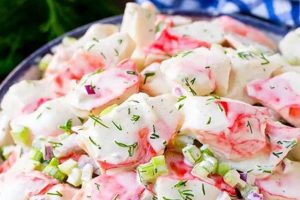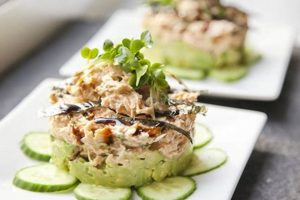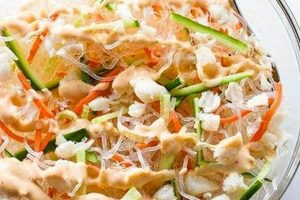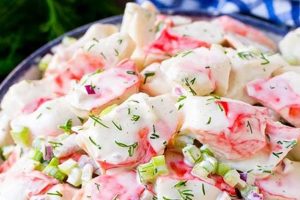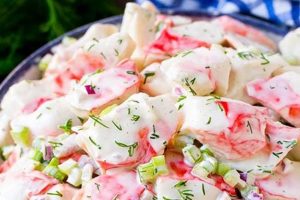Dishes featuring premium-quality crab meat, lightly bound with mayonnaise and seasonings, represent a culinary delicacy enjoyed worldwide. These preparations often incorporate fresh herbs, vegetables, and spices to complement the sweet, delicate flavor of the crab. Examples include classic presentations served chilled on lettuce cups or crackers, as well as innovative variations incorporated into sandwiches, deviled eggs, or avocado halves.
The popularity of these crab-centric dishes stems from the combination of luxurious taste and relatively simple preparation. Using high-quality, pre-cooked crab meat minimizes cooking time, making these dishes ideal for entertaining or a quick, elegant meal. Historically, such recipes have graced tables from casual picnics to formal banquets, showcasing the versatility and enduring appeal of the core ingredient. The nutritional value of crab meat, rich in protein and essential minerals, further enhances its desirability.
This exploration will delve into variations on this culinary theme, from traditional preparations to contemporary twists, offering guidance on ingredient selection, preparation techniques, and presentation ideas.
Tips for Exceptional Crab Salad
Achieving optimal flavor and texture in crab salad relies on careful ingredient selection and proper handling techniques. The following tips offer guidance for creating a superior culinary experience.
Tip 1: Prioritize Quality Crab Meat: Opt for premium lump or jumbo lump crab meat for the best flavor and texture. Avoid using canned or imitation crab, as these lack the delicate sweetness and tender texture of fresh crab.
Tip 2: Handle Crab Meat Gently: Overmixing can break down delicate crab lumps, resulting in a mushy texture. Combine ingredients with a light hand, using a folding motion to preserve the integrity of the crab meat.
Tip 3: Balance Flavors Carefully: The subtle sweetness of crab meat should be enhanced, not overpowered, by other ingredients. Use mayonnaise sparingly and season judiciously with complementary flavors like fresh herbs, lemon juice, and a touch of Dijon mustard.
Tip 4: Chill Thoroughly Before Serving: Chilling allows the flavors to meld and enhances the refreshing qualities of the salad. Refrigerate for at least 30 minutes before serving.
Tip 5: Consider Texture and Presentation: Add a variety of textures with finely diced celery, red onion, or bell peppers. Serve on crisp lettuce cups, crackers, or toasted baguette slices for an appealing presentation.
Tip 6: Explore Flavor Variations: While classic preparations are timeless, consider incorporating other ingredients like avocado, mango, or grapefruit for unique flavor profiles.
Tip 7: Proper Food Safety Practices: Ensure all ingredients are fresh and handled safely. Keep cold ingredients chilled until ready to use and avoid leaving the finished salad at room temperature for extended periods.
By adhering to these guidelines, one can elevate crab salad from a simple dish to a truly memorable culinary creation. Careful attention to detail, from ingredient selection to presentation, ensures a delightful dining experience.
With these tips in mind, the following sections will explore specific recipe variations and offer further guidance on crafting the perfect crab salad.
1. Fresh, High-Quality Lump Crab
Fresh, high-quality lump crab meat forms the cornerstone of exceptional crab salad. The inherent sweetness and delicate texture of premium crab meat directly influence the final dish’s quality. Using inferior or canned crab meat compromises the flavor profile, resulting in a less satisfying culinary experience. The structural integrity of lump crab meat, characterized by large, intact pieces, is essential for both aesthetic appeal and textural enjoyment. For instance, a salad crafted with fresh jumbo lump crab meat offers a luxurious mouthfeel and a clean, briny flavor, while a salad made with shredded or canned crab will likely be mushy and lack the characteristic sweetness.
The importance of freshness extends beyond flavor and texture. Fresh crab meat minimizes the risk of bacterial contamination and ensures optimal food safety. Proper handling and refrigeration are crucial to maintain freshness and prevent spoilage. Reputable seafood markets prioritize sourcing and handling practices that preserve the quality and safety of their products. Choosing a reliable supplier guarantees access to crab meat that meets high standards of freshness, contributing significantly to the overall success of the crab salad.
In summary, the quality of lump crab meat directly impacts the sensory experience and safety of crab salad. Prioritizing fresh, high-quality lump crab meat ensures a superior dish that showcases the delicate sweetness and luxurious texture characteristic of this premium ingredient. Understanding this connection empowers culinary enthusiasts to make informed decisions when selecting ingredients and crafting exceptional crab salad recipes. The investment in premium crab meat translates directly to a more satisfying and enjoyable dining experience.
2. Minimal, Complementary Seasonings
The delicate flavor profile of lump crab meat benefits from a judicious approach to seasoning. Overly assertive flavors can easily mask the subtle sweetness of the crab, diminishing the overall quality of the salad. Minimal, complementary seasonings enhance the natural flavors of the crab without overpowering them. This approach allows the inherent quality of the primary ingredient to shine through.
- Fresh Herbs:
Fresh herbs, such as dill, chives, tarragon, and parsley, provide brightness and complexity without overwhelming the crab. Dill, with its subtle anise notes, pairs particularly well with seafood. A small amount of finely chopped chives adds a delicate onion flavor, while tarragon offers a slightly licorice-like nuance. Parsley contributes a fresh, clean taste. The key is to use these herbs sparingly, allowing their subtle flavors to complement the crab.
- Zest and Juice of Citrus Fruits:
Lemon or lime zest and juice provide a refreshing acidity that balances the richness of the mayonnaise and enhances the sweetness of the crab. The zest imparts aromatic oils that elevate the overall flavor profile. A small amount of juice adds brightness without making the salad overly tart. Using freshly squeezed juice ensures optimal flavor and avoids the bitterness sometimes found in bottled varieties.
- Dijon Mustard:
A touch of Dijon mustard adds a subtle tang and complexity to the salad. The sharp, slightly spicy notes of Dijon complement the sweetness of the crab and create a balanced flavor profile. Dijon also acts as an emulsifier, helping to bind the ingredients together. However, as with other seasonings, moderation is key. Too much Dijon can overpower the delicate flavor of the crab.
- Salt and White Pepper:
Salt enhances the natural flavors of the crab and other ingredients. White pepper provides a subtle heat without the visual distraction of black pepper flecks. Using freshly ground white pepper ensures optimal flavor and aroma. It’s important to season judiciously, tasting and adjusting as needed to avoid over-salting or overpowering the delicate balance of flavors.
By focusing on minimal, complementary seasonings, the natural sweetness and delicate texture of lump crab meat take center stage. The careful selection and application of these supporting flavors create a harmonious balance that elevates the overall culinary experience. This nuanced approach to seasoning distinguishes exceptional crab salad from mediocre versions, demonstrating a deep understanding of flavor dynamics and a commitment to showcasing the quality of the primary ingredient. The result is a dish that is both refreshing and elegant, allowing the inherent flavors of the crab to shine through.
3. Proper Mayonnaise Proportion
Mayonnaise plays a crucial binding role in lump crab salad recipes, but its proportion significantly impacts the final product’s quality. Too much mayonnaise creates a heavy, gloppy texture that overwhelms the delicate crab flavor. Conversely, too little mayonnaise results in a dry, crumbly salad lacking cohesion. The ideal proportion balances binding ingredients while allowing the crab’s natural sweetness and texture to shine through. This balance ensures a harmonious blend of flavors and textures, creating a light yet cohesive salad.
Consider two contrasting examples: A crab salad saturated with mayonnaise resembles a thick paste, obscuring the crab’s delicate texture and flavor. The excessive richness overwhelms the palate, leaving a heavy, greasy impression. In contrast, a crab salad with insufficient mayonnaise appears dry and disjointed. The individual ingredients fail to meld, resulting in a less satisfying sensory experience. The crab meat, while present, lacks the cohesive texture that mayonnaise provides. These examples highlight the importance of finding the right balance. The perfect mayonnaise proportion binds the ingredients just enough to create a cohesive salad without masking the crab’s flavor or compromising its delicate texture.
Understanding the proper mayonnaise proportion is fundamental to achieving a successful lump crab salad. This knowledge allows one to create a salad that showcases the quality of the crab meat while providing a pleasant, cohesive texture. Over-reliance on mayonnaise compromises both flavor and texture, while insufficient mayonnaise hinders the salad’s ability to bind properly. Mastering this balance distinguishes exceptional crab salad from mediocre versions, demonstrating an understanding of the interplay between ingredients and their impact on the final dish. A well-balanced crab salad allows the natural flavors and textures of the ingredients to harmonize, creating a light, refreshing, and truly enjoyable culinary experience.
4. Textural Variety
Textural variety elevates lump crab salad beyond a simple mixture of ingredients, transforming it into a multi-sensory experience. The interplay of textures creates a dynamic mouthfeel that complements the delicate flavor of the crab meat. Consider the contrast between the soft, flaky texture of lump crab and the crisp snap of finely diced celery or the gentle crunch of red onion. These contrasting textures create a more engaging and satisfying culinary experience. A monotonous texture, even with high-quality crab, can result in a less enjoyable dish. For instance, a crab salad composed solely of soft ingredients might feel heavy and lack vibrancy. The addition of crisp vegetables introduces a refreshing counterpoint, preventing the salad from becoming overly rich or monotonous.
Achieving textural variety involves careful selection and preparation of ingredients. Finely diced vegetables, such as celery, red onion, and bell peppers, offer a crisp contrast to the soft crab. The size of the dice influences the perceived texture; a smaller dice provides a more delicate crunch, while a larger dice offers a more pronounced bite. Toasted nuts, such as slivered almonds or chopped pecans, introduce another layer of textural complexity. Their crispness and subtle nuttiness complement the crab’s sweetness. Even the choice of serving vessel contributes to textural variety. Serving the salad on crisp lettuce cups or crackers provides a contrasting crunch, while a soft bed of avocado offers a creamy counterpoint.
The strategic incorporation of textural variety distinguishes exceptional lump crab salad from simpler versions. This attention to detail demonstrates a sophisticated understanding of sensory perception and its impact on culinary enjoyment. Beyond mere flavor, textural contrast elevates the dining experience, making each bite more engaging and memorable. Understanding the interplay of textures allows for a more nuanced approach to recipe development, transforming a simple crab salad into a truly delightful culinary creation. This principle extends beyond specific recipes, highlighting the broader importance of textural consideration in culinary arts.
5. Careful Handling
Careful handling proves essential in preserving the delicate structure and flavor of lump crab meat, a key component of high-quality crab salad. The inherent tenderness of lump crab makes it susceptible to damage from rough handling. Overmixing or aggressive stirring can easily break down the delicate lumps, resulting in a mushy, unappetizing texture. This degradation not only compromises the aesthetic appeal of the salad but also diminishes the desirable textural experience. Consider the contrast between intact, succulent lumps of crab meat and a shredded, paste-like consistency. The former exemplifies careful handling, while the latter reflects a disregard for the ingredient’s fragility.
The importance of careful handling extends beyond mixing. Improper thawing techniques can also negatively impact the crab’s texture. Thawing crab meat rapidly, such as in a microwave, can cause it to become tough and rubbery. Slow thawing in the refrigerator preserves the delicate texture and minimizes moisture loss. Furthermore, the tools used during preparation matter. Using a rubber spatula or large spoon to gently fold ingredients together minimizes damage to the crab meat, preserving its structural integrity. Metal forks or whisks, however, can easily shred the delicate lumps, leading to an undesirable outcome. Even the act of transferring the crab meat from container to mixing bowl requires a gentle touch to avoid unnecessary breakage.
Careful handling, therefore, represents a fundamental principle in lump crab salad preparation. It directly influences the final product’s texture, appearance, and overall appeal. This understanding translates into practical steps: selecting appropriate thawing methods, utilizing gentle mixing techniques, and employing suitable tools. These practices preserve the inherent qualities of the crab meat, ensuring a visually appealing and texturally satisfying salad. Ultimately, careful handling demonstrates respect for the quality of the ingredients and contributes significantly to the overall success of the dish.
6. Elegant Presentation
Elegant presentation elevates lump crab salad from a simple dish to a refined culinary experience. Visual appeal significantly influences perception of flavor and enjoyment. A thoughtfully presented salad enhances the dining experience, creating a sense of occasion and demonstrating care in preparation. This connection between presentation and enjoyment stems from the inherent human appreciation for aesthetics. A visually appealing dish stimulates appetite and sets the stage for a positive sensory experience. For example, a simple crab salad served on a bed of crisp lettuce within individual endive spears or arranged artfully on a platter garnished with fresh herbs and edible flowers immediately communicates elegance. This visual appeal enhances the perceived value and enjoyment of the dish, even before the first bite is taken. Conversely, a carelessly plated salad, regardless of its intrinsic quality, may appear less appealing and diminish the overall dining experience.
Practical applications of elegant presentation vary depending on context. For a casual lunch, attractive serving bowls and individual ramekins suffice. More formal settings benefit from intricate plating techniques, such as using a ring mold to create a composed salad or piping the mixture onto delicate crackers or cucumber rounds. Garnishes play a crucial role, adding visual interest and complementary flavors. Fresh herbs, edible flowers, a sprinkle of paprika, or a drizzle of high-quality olive oil can transform a simple presentation into a sophisticated display. Consideration should also be given to the serving vessels and accompanying elements, such as the choice of plates, cutlery, and napkins. These details contribute to the overall aesthetic and create a cohesive dining experience. The choice of presentation should also reflect the occasion and the overall theme of the meal.
In summary, elegant presentation significantly enhances the enjoyment of lump crab salad. Visual appeal stimulates appetite and elevates the perceived value of the dish. Practical application ranges from simple yet attractive arrangements to more elaborate plating techniques, depending on the context. Understanding the impact of presentation empowers culinary enthusiasts to create dishes that are not only delicious but also visually captivating, transforming a simple meal into a memorable occasion. This principle underscores the broader importance of presentation in culinary arts, demonstrating how visual elements contribute significantly to the overall dining experience.
7. Chilling Before Service
Chilling lump crab salad before service is a crucial step that significantly impacts both food safety and sensory experience. This practice allows flavors to meld, enhances textures, and ensures the dish is served at an optimal temperature for enjoyment. Understanding the reasons behind this practice clarifies its importance in creating a successful and enjoyable culinary experience.
- Flavor Development
Chilling allows the individual flavors of the ingredientsthe sweetness of the crab, the tang of the mayonnaise, the brightness of the herbs and seasoningsto harmonize. This melding of flavors creates a more complex and balanced flavor profile compared to a freshly mixed salad. The chilling process allows the flavors to mature and deepen, resulting in a more nuanced and satisfying taste. For example, the subtle notes of fresh dill or the zest of lemon become more pronounced after a period of chilling, enhancing the overall flavor composition of the salad.
- Texture Enhancement
Chilling firms the texture of the crab salad, making it easier to handle and serve. The cold temperature also enhances the perceived crispness of any added vegetables, such as celery or bell pepper, creating a more pleasing textural contrast. A chilled salad holds its shape better, whether served in lettuce cups, on crackers, or as a sandwich filling. This improved texture contributes to a more refined and enjoyable dining experience.
- Food Safety
Chilling inhibits bacterial growth, a critical consideration for any dish containing mayonnaise. Mayonnaise-based salads are susceptible to bacterial contamination if left at room temperature for extended periods. Chilling ensures the salad remains safe to consume, particularly important during warmer months or when serving large groups. Adhering to proper food safety guidelines minimizes the risk of foodborne illness.
- Enhanced Sensory Experience
Serving the salad chilled enhances the overall sensory experience. The cool temperature provides a refreshing contrast, especially during warmer weather. The chilled temperature also accentuates the delicate flavors and textures of the salad, making them more perceptible to the palate. This attention to temperature elevates the dining experience, demonstrating care and attention to detail. A chilled crab salad is more invigorating and palatable, offering a more complete sensory experience.
Chilling lump crab salad before service, therefore, represents a critical step that influences both food safety and sensory enjoyment. This practice allows the flavors to meld, enhances textures, and ensures a safe and refreshing dining experience. Understanding the reasons behind this practice allows culinary enthusiasts to fully appreciate its importance in creating a successful and enjoyable crab salad. By chilling the salad, one demonstrates a commitment to both culinary excellence and the well-being of those partaking in the meal.
Frequently Asked Questions
This section addresses common inquiries regarding the preparation and enjoyment of lump crab salad.
Question 1: What is the best type of crab meat for crab salad?
Jumbo lump or lump crab meat is recommended for optimal flavor and texture. These grades offer the largest, most intact pieces of crab meat, resulting in a luxurious and visually appealing salad.
Question 2: Can frozen crab meat be used?
Frozen crab meat can be used, but proper thawing is crucial. Thaw slowly in the refrigerator to maintain the crab’s delicate texture and prevent excessive moisture loss. Avoid rapid thawing methods like microwaving, which can result in a tough, rubbery texture.
Question 3: How long can crab salad be stored?
Crab salad should be refrigerated and consumed within two days of preparation. Due to the perishable nature of seafood and mayonnaise, extended storage increases the risk of spoilage and bacterial growth.
Question 4: What are common signs of spoiled crab salad?
Spoiled crab salad may exhibit a sour or unpleasant odor, a slimy texture, or discoloration. If any of these signs are present, the salad should be discarded immediately.
Question 5: Can crab salad be frozen?
Freezing crab salad is not recommended. Freezing negatively impacts the texture of both the crab meat and the mayonnaise, resulting in a watery and less palatable salad upon thawing.
Question 6: What are some suitable accompaniments for crab salad?
Crab salad pairs well with crackers, toasted baguette slices, lettuce cups, avocado halves, or cucumber rounds. These accompaniments provide textural contrast and complement the delicate flavor of the crab.
Addressing these common inquiries clarifies important aspects of crab salad selection, preparation, and storage. Prioritizing food safety and ingredient quality ensures an enjoyable culinary experience.
The following sections provide specific recipe variations and additional tips for crafting exceptional lump crab salad.
Conclusion
Culinary exploration of optimal lump crab salad recipes necessitates meticulous attention to detail, from ingredient selection to presentation. Prioritizing fresh, high-quality lump crab meat establishes a foundation for exceptional flavor and texture. Judicious use of complementary seasonings, proper mayonnaise proportion, and incorporation of textural variety further elevate the sensory experience. Careful handling preserves the delicate nature of the crab meat, while elegant presentation enhances visual appeal. Finally, chilling before service allows flavors to meld and ensures optimal food safety. These considerations collectively contribute to a refined and enjoyable culinary creation.
Emphasis on quality ingredients and thoughtful preparation distinguishes exceptional lump crab salad from mediocre iterations. This understanding empowers culinary practitioners to create dishes that showcase the delicate sweetness and luxurious texture of this prized ingredient. Continued exploration of flavor combinations and presentation techniques promises further evolution of this culinary classic.

